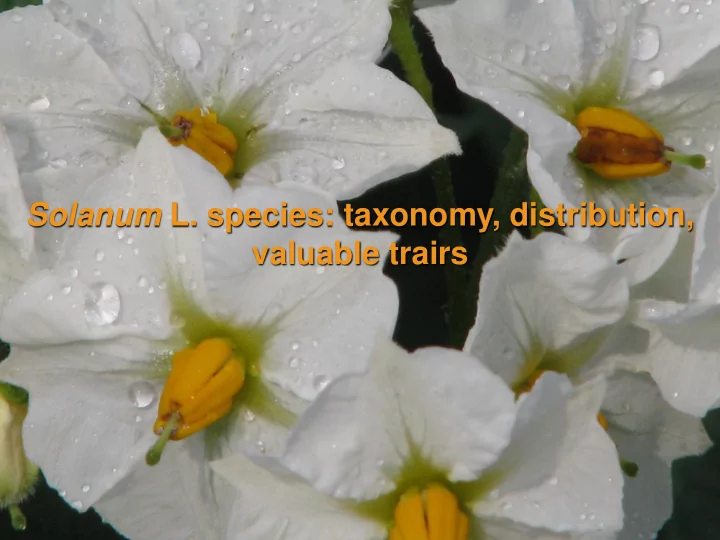

Solanum L. species: taxonomy, distribution, valuable trairs
The cultivated potato Solanum tuberosum L. originated from the Andean Region of South America. Potato was first domesticated and eaten by man in South America particularly in the region of the Andes about 8000 years ago. Potato is one of the most important food crops in the world and is ranked at the fourth place in world food production after wheat, corn and rice.
Nutritional value per 100 g (row with peel) Energy 321 kJ (77 kcal) Iron 1.8 mg (14%) Carbohydrates 19 g Magnesium 23 mg (6%) Starch 15 g Phosphorus 57 mg (8%) Dietary fiber 2.2 g Potassium 421 mg (9%) Fat 0.1 g Sodium 6 mg (0%) Protein 2 g Calcium 12 mg (1%) 75 g Water
Vitamins (per 100 g): Thiamine (Vit. B 1 ) 0.08 mg (6%) Riboflavin (Vit. B 2 ) 0.03 mg (2%) Niacin (Vit. B 3 ) 1.1 mg (7%) Vitamin B 6 0.25 mg (19%) Vitamin C 20 mg (33%)
Potato can be grown widely under various climatic conditions at various altitudes because its high adaptation ability.
Wild potatoes occur between 38 ° N and 41 ° S, with more species in the southern hemisphere. Species richness is highest between 8 ° and 20 ° S and around 20 ° N. Wild potatoes typically occur between 2000 and 4000 m altitude.
Wild potatoes occur in 16 countries., but 88% of the observations are from Argentina, Bolivia, Mexico, and Peru. High species richness occurs in northern Argentina, central Bolivia, central Ecuador, central Mexico, and south and north-central Peru. Peru has the highest number of species (93), followed by Bolivia (39).
Corolla shapes
Variation in Solanum andigenum tuber morphology
Botanical series of Central American species Series Morelliformia Hawkes Series Bulbocastana Rydb. Series Conicibaccata Bitter Series Longipedicellata Bukasov Series Demissa Bukasov Series Pinnatisecta (Rydb.) Hawkes Series Tuberosa (Rydb.) Hawkes
Hawkes (1990) and Gorbatenko (1989) recognize 15 and 20 series,respectively, for the South American species, and Hawkes (1990) and Bukasov (1978) recognize 21and 36 series, respectively.
Botanical series of South American species Series Commersoniana Buk. Series Circaeifolia Hawkes Series Conicibaccata Bitter Series Cuneoalata Hawkes Series Acaulia Juz. Series Megitstacroloba Cardenas & Hawke Series Tuberosa (Rydb .) Hawkes
In a nature there are several ploidy levels, varying from diploid (2n = x = 24) to hexaploid (2n = 6x = 72). Commonly cultivated potato varieties are being a tetraploids (2n=4x=48).
Differences in ploidy lead to difficulties to use wild species in cross with S. tuberosum . There are the barriers in cross ability in species with different ploidy levels.
Crosses
Triple diploid interspecific potato hybrid
Potato breeding is aimed at improving resistance to many potato diseases. Wild species of the genus are widely distributed from Central America Solanum to South America. Utilization of wild Solanum germplasm could broaden the genetic resistance base of the cultivated potato.
Evaluation of potato breeding lines for resistance to Early Blight caused by Alternaria solani
Wild potato species are being to be the valuable source of genes for resistance to harmful organisms. To obtain late blight resistance, breeders are focused on the introgression of dominant resistance genes from wild potato species originated from Mexico. A potato tuber ruined by late blight
Late Blight Caused by Phytophthora infestans is the causal agent of late blight, which is the most devastating disease in potato worldwide. It caused the great Irish famine in the 1840s resulting in famine- related diseases, which caused the death of over 1 million people and lead to the emigration of over 1.5 million people. The economic value of loss caused by late blight costs of crop protection have been estimated at 5 billion US$ annually.
The pathogen P. infestans belongs taxonomically to the oomycetes.
The necessity of developing varieties with durable resistance increases because sexual reproduction of pathogen leads to more virulent and fungicide-resistant strains of P. infestans occurrence. A1 x and A2 mating types
Black ‘ s differential set (r, R1-R11)
During the first half of the 20th century, eleven dominant R genes (R1-R11) from the wild species S. demissum were discovered The genetic spectrum of resistance genes in S. guerreroense was not yet studied. It is very probably that S. guerreroense is also reach with major genes for resistance to P. infestans because it is phylogenetically close to S. demisum . Both species are hexaploid (2n = 6x = 72) .
Hybrid progeny from S. guerreroense Corr.
Evaluation in glasshouse and in field experiments
Inoculation of yang seedlings with Phytophthora infestans
Inoculation with P. infestans detached leaflets
Leaflet tests
Reaction of hypersensitivity on leaves of plants possessing R -genes after inoculation with P. infestans
Tuber testing S. tuberosum
interspecific hybrids
Tubers of S. guerreroense hybrid progenies with necrotic reaction to inoculation with P. infestans
Hybrid cv. Aurora x ( S. tuberosum x S. phureja ). Source of gene for resistance to P. infestans R3a.
Hybrid S. guerreroense x Black differential line R5. Source of genes for resistance to P. infestas R1 and R3a
Hybrid S. guerreroense x S. andigenum. Source of gene for resistance to nematod Ro1.
Genes for resistance to Globodera rostochiensis and Phytophthora infestans detected in five interspecific potato hybrids Number of plants with detected resistance genes No. Number In of tested Globodera Phytophthora 2011 plants rostochiensis infestans Ro1 Gro1 R1 R3a 1 24 24 0 1 0 2 28 28 - 12 18 5 20 20 - 0 11 6 6 6 - 0 0 7 7 7 - 0 0
The weight of tubers at a third part of S. guerreroense hybrid progenies exceeded those formed in plants of S. guerreroense in 3- 7 times.
Tubers of parental wild accession (to left) and its hybrid progeny from cross with cultivated Solanum phureja
Acknowledgements Materials used in these lection have been co- funded by EU Structural Funds (project: “Development, improvement and implementation of environmentally friendly and sustainable crop breeding technologies” , 2009/0218/1DP/1.1.1.2.0/09/APIA/VIAA/099 ), Latvian Council of Science, Latvian National Programme in Agrobiotechnology
Recommend
More recommend